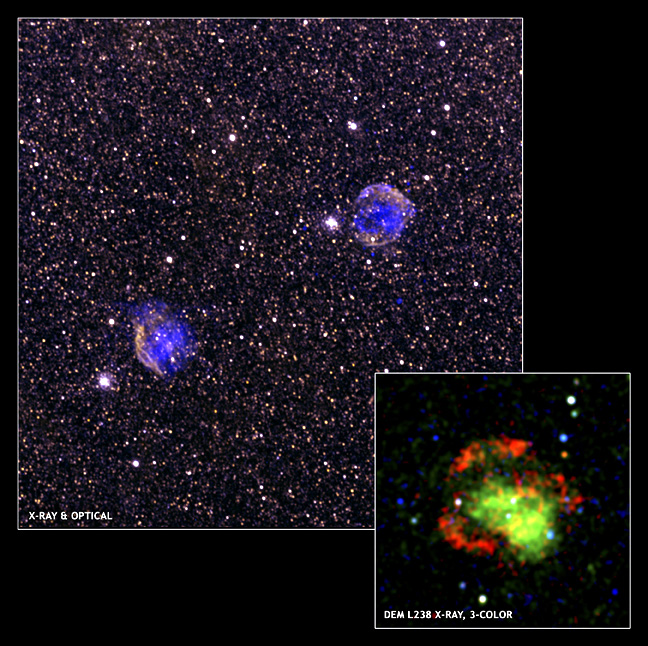
 Credit:NASA/CXC/NCSU/Borkowski et al. (X-ray); NOAO/AURA/NSF/Points/Smith (optical)
Credit:NASA/CXC/NCSU/Borkowski et al. (X-ray); NOAO/AURA/NSF/Points/Smith (optical)
Fast Fuse
The "standard candle" is one of the holy grails of astronomy: a class of objects all of which have the same brightness, so a measure of relative brightness immediately turns into a measure of relative distance. The closest thing astronomers have to such a standard is a particular type of supernovae, the "Type Ia's" which are believed to occur when a white dwarf star accretes enough matter that the star can no longer support itself against gravity. But white dwarfs are the embers of low mass stars, which take billions of years to evolve to the white dwarf stage. This means that there should be few or no Type Ia supernovae until the Universe reached an age of a few billion years. But new evidence from the Chandra and XMM-Newton X-ray observatories suggest that this simple picture may be more complicated. The image above shows a composite X-ray image (in blue) from Chandra and an optical image (in white) of two supernovae in the Large Magellenic Cloud. The inset shows a "true color" X-ray image of one of the supernovae from the XMM-Newton observatory. The green color at the center of the supernova remnant is produced by iron atoms contained in the stellar wreckage, and such large amounts of iron are typical of Type Ia supernovae. But the X-ray data also show that the remnants are unexpectedly dense and bright in X-rays. This may mean that each star exploded into a very dense environment created when the progenitors were relatively young, only 100 million years or so old. If true this might mean that Type Ia supernovae might have existed in the early Universe, and that they might be useful probes of the early Universe. Or it might mean that these "standard candles" are not so standard.
<
HEA Dictionary ● Archive
● Search HEAPOW
● Other Languages
● HEAPOW on Facebook
● Download all Images
● Education ● HEAD
>
Each week the HEASARC
brings you new, exciting and beautiful images from X-ray and Gamma ray
astronomy. Check back each week and be sure to check out the HEAPOW archive!
Page Author: Dr. Michael F. Corcoran
Last modified Monday, 26-Feb-2024 17:45:58 EST


